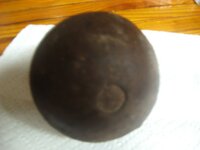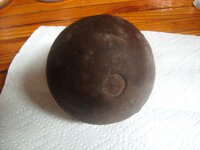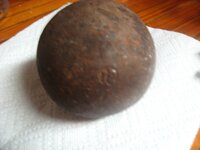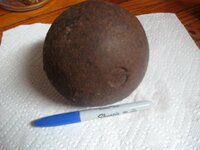I got this from a junk shop. The woman there didn't know anything about it, but called it a cannonball. I don't know either and was hoping you could shed some light on the subject. I know the shot put balls and mill grinding balls look like this too, so I was hoping for some insight. Thanks. I've attached some pics so you could see what I have. Thanks! Vicki
Navigation
Install the app
How to install the app on iOS
Follow along with the video below to see how to install our site as a web app on your home screen.
Note: This feature may not be available in some browsers.
More options
You are using an out of date browser. It may not display this or other websites correctly.
You should upgrade or use an alternative browser.
You should upgrade or use an alternative browser.
✅ SOLVED cannonball?
- Thread starter svterry
- Start date
Bryanhashemi
Hero Member
- Mar 15, 2012
- 548
- 108
- Detector(s) used
- Minelab E-trac, whites xlt
- Primary Interest:
- Relic Hunting
Your probably going to have to give the exact size of it for better insight. If it is a cannonball be carefully because the fuse could still be intact meaning its live from the pic. It looks like the hole went all the way through at one time..if that's the case then I would think its not a cannonball
Upvote
0
ohiowhiteguy
Hero Member
- Oct 11, 2012
- 662
- 702
- Detector(s) used
- coin master pro,,,Garrett at pro,,, Garrett carrot
- Primary Interest:
- All Treasure Hunting
hit it with a hammer. then you'll know..and if we don't hear back from ya in a while.. sorry bout that.....
owg
owg
Upvote
0
TheCannonballGuy
Gold Member
- Feb 24, 2006
- 6,593
- 13,357
- Detector(s) used
- White's 6000, Nautilus DMC-1, Minelab
- Primary Interest:
- Relic Hunting
In actual well-documented fact, you CAN hit a cannonball all day long with a hammer, and nothing will happen except your arm gets tired. I do exactly that, often, in cleaning the rust-crust off of them. Been doing it to hundreds of cannonballs, for nearly 40 years, and I can still count to ten on my fingers. (Check the info in my Profile under "About me.") The un-deniable proof: we relic-hunters have dug up more than 100,000 civil war shells, nearly every one of which got struck with the shovel (several times) during the digging... without causing a single one of them to explode. The very-very-few civil war era ones which have exploded did so because somebody was using a power-tool (such as a drill) on it, or put it into a bonfire, for thrills. It's the 20th-Century projectiles you need to worry about. The problem is, most people cannot tell the difference between a civil war artillery shell and a 20th-Century shell... so, it's best to be properly cautious (but not Paranoid) about bullet-shaped ones. Anybody who owns one and is uncertain about its time-period can post photos of it here in the What-Is-It forum for identification and time-period dating.
Svterry/Vicki, welcome to TreasureNet and the What-Is-It forum.
Your final photo seems to show a number on your iron/steel ball. If that is a number on it, it is not an artillery ball. If the number is a 12, as it seems to be, it is a Sports Shot Put ball. Absolutely no actual cannonballs were marked with their weight, in any era of artillery history.
The simplest way to tell if an iron ball is a cannonball or not is to weigh it on a precision weighing-scale, such as a Postal Shipping scale, which measures weight in not just pounds but in ounces too. (Typical household bathroom scales are horribly inaccurate -- so forget that kind.) If the ball's weight doesn't match up precisely with one of the weights given in the Ordnance Manual data at the following website, it is not an artillery ball. Cannon bore, shot, and shell diameters for smoothbore guns
The Ordnance Manual's historical data-charts tell the exact diameter and super-precise weight of every kind of artillery ball (cannnon-ball, grapeshot-ball, and canister-ball) used in America from the American Revolution through the end of the Civil War. If you can't find a matchup in the Historical data for your iron ball's exact diameter (not counting any rust/dirt-encrustation, which must be removed) and precisely-measured weight, it is absolutely not an artillery ball. (or at least, not one used in America.)
Svterry/Vicki, welcome to TreasureNet and the What-Is-It forum.
Your final photo seems to show a number on your iron/steel ball. If that is a number on it, it is not an artillery ball. If the number is a 12, as it seems to be, it is a Sports Shot Put ball. Absolutely no actual cannonballs were marked with their weight, in any era of artillery history.
The simplest way to tell if an iron ball is a cannonball or not is to weigh it on a precision weighing-scale, such as a Postal Shipping scale, which measures weight in not just pounds but in ounces too. (Typical household bathroom scales are horribly inaccurate -- so forget that kind.) If the ball's weight doesn't match up precisely with one of the weights given in the Ordnance Manual data at the following website, it is not an artillery ball. Cannon bore, shot, and shell diameters for smoothbore guns
The Ordnance Manual's historical data-charts tell the exact diameter and super-precise weight of every kind of artillery ball (cannnon-ball, grapeshot-ball, and canister-ball) used in America from the American Revolution through the end of the Civil War. If you can't find a matchup in the Historical data for your iron ball's exact diameter (not counting any rust/dirt-encrustation, which must be removed) and precisely-measured weight, it is absolutely not an artillery ball. (or at least, not one used in America.)
Last edited:
Upvote
0
HutSiteDigger
Silver Member
- Nov 26, 2012
- 2,849
- 1,283
- Detector(s) used
- Fisher 1266x and a shovel
- Primary Interest:
- All Treasure Hunting
I have heard a few ketchum grenades from the cw are more easily too go off if you hit them with your shovel but like CannonB is saying you could drove over a cw cannonball with a backhoe and it wont prolly go off til you get a drill or fire going!
Upvote
0
TheCannonballGuy
Gold Member
- Feb 24, 2006
- 6,593
- 13,357
- Detector(s) used
- White's 6000, Nautilus DMC-1, Minelab
- Primary Interest:
- Relic Hunting
Dug-up civil war grenades (such as the Ketchum grenade) won't explode if you drop them. Again, the problem is most people can't tell the difference between a civil war grenade and a 20th-century one.
Upvote
0
HutSiteDigger
Silver Member
- Nov 26, 2012
- 2,849
- 1,283
- Detector(s) used
- Fisher 1266x and a shovel
- Primary Interest:
- All Treasure Hunting
Thats good to know my father has over 20 different cannonballs and the guy who defused them made a bunker back behind his house then would have a robot go in and defuse them he told my dad that maybe 1 out of a 300 would explode during the process, there was also a guy down toward your area a few years back who got killed by one while defusing it in his garage.
Upvote
0
TheCannonballGuy
Gold Member
- Feb 24, 2006
- 6,593
- 13,357
- Detector(s) used
- White's 6000, Nautilus DMC-1, Minelab
- Primary Interest:
- Relic Hunting
He was a personal friend of mine. He was using a power-tool on it. Only two people have been killed by a civil war artillery shell in the 20th-Century (or later), and both of them were using a power-tool on the shell at the time.
Upvote
0
HutSiteDigger
Silver Member
- Nov 26, 2012
- 2,849
- 1,283
- Detector(s) used
- Fisher 1266x and a shovel
- Primary Interest:
- All Treasure Hunting
Sorry too hear about that CannonBall i kind of figured you may have knew him after i wrote that it dawned on me. I do not know how you go about dealing with losing a friend but he passed away doing something he loved too do and sometimes thats the best way to go. I heard he was a master at cannonballs like you and it is almost impossible to find people like that these days.
Upvote
0
- Thread starter
- #11
Thank you so much. I knew that someone would know. From the pictures that I've seen of a real cannonball, there is a seam, which this does not have. I think it may be cast iron but I guess there's no way to tell. It is a number 12 stamped into it and there is that plug. Did they fill it with something-- like sand? Thanks again for your insight. I'll probably still use it in my classroom to show the kids what a cannonball is like.
Vicki
Vicki
Upvote
0
TheCannonballGuy
Gold Member
- Feb 24, 2006
- 6,593
- 13,357
- Detector(s) used
- White's 6000, Nautilus DMC-1, Minelab
- Primary Interest:
- Relic Hunting
Yes, it was Sam. That incident shows that even a long-experienced Professional can accidentally overlook an important point in the Safety Checklist -- as the OSHA on-the-job injury statistics for (let's say, car-mechanics) show.
Upvote
0
TheCannonballGuy
Gold Member
- Feb 24, 2006
- 6,593
- 13,357
- Detector(s) used
- White's 6000, Nautilus DMC-1, Minelab
- Primary Interest:
- Relic Hunting
Svterry (the iron ball's owner) wrote:
> From the pictures that I've seen of a real cannonball, there is a seam, which this does not have.
Svterry, some real cannonballs do have a moldseam, and some don't. Most Revolutionary War cannonballs do. Most civil war yankee ones don't -- and many (but not all) Confederate ones do. Also, many Mining-&-Stonemilling Industry rock-crusher balls have a moldseam. So, we historians and relic-collectors cannot give much weight to the presence or absence of a moldseam, and must rely on precision measuring and weighing, for comparison with the Ordnance Manual's historical data charts telling the very-exact diameter and weight of real cannonballs.
Svterry also wrote:
> It is a number 12 stamped into it and there is that plug. Did they fill it with something-- like sand?
Yes, some (but not nearly all) Sports Shot Put balls do have a plug, which closes a hole that allows you to add sand or some other material, for adjusting the ball's weight to exactly 12.00 pounds (or whatever weight it needs to be). The reason a Shot Put ball's weight needs to be that precise is for fairness in sports competition. It's unfair if the ball used by one Shot Put contestant weighs even a half-ounce less than the other contestant's ball.
> From the pictures that I've seen of a real cannonball, there is a seam, which this does not have.
Svterry, some real cannonballs do have a moldseam, and some don't. Most Revolutionary War cannonballs do. Most civil war yankee ones don't -- and many (but not all) Confederate ones do. Also, many Mining-&-Stonemilling Industry rock-crusher balls have a moldseam. So, we historians and relic-collectors cannot give much weight to the presence or absence of a moldseam, and must rely on precision measuring and weighing, for comparison with the Ordnance Manual's historical data charts telling the very-exact diameter and weight of real cannonballs.
Svterry also wrote:
> It is a number 12 stamped into it and there is that plug. Did they fill it with something-- like sand?
Yes, some (but not nearly all) Sports Shot Put balls do have a plug, which closes a hole that allows you to add sand or some other material, for adjusting the ball's weight to exactly 12.00 pounds (or whatever weight it needs to be). The reason a Shot Put ball's weight needs to be that precise is for fairness in sports competition. It's unfair if the ball used by one Shot Put contestant weighs even a half-ounce less than the other contestant's ball.
Last edited:
Upvote
0
detectingarizona
Full Member
- Feb 4, 2013
- 128
- 20
- Detector(s) used
- bounty hunter challenger, and Ace 250, gold nugget bucket!
- Primary Interest:
- All Treasure Hunting
looks like a shot put ball
Upvote
0
gsxraddict
Hero Member
- Sep 21, 2005
- 629
- 413
- Detector(s) used
- XP Deus, Minelab Equinox 800, Whites V3i
- Primary Interest:
- Relic Hunting
In actual well-documented fact, you CAN hit a cannonball all day long with a hammer, and nothing will happen except your arm gets tired. I do exactly that, often, in cleaning the rust-crust off of them. Been doing it to hundreds of cannonballs, for nearly 40 years, and I can still count to ten on my fingers. (Check the info in my Profile under "About me.") The un-deniable proof: we relic-hunters have dug up more than 100,000 civil war shells, nearly every one of which got struck with the shovel (several times) during the digging... without causing a single one of them to explode. The very-very-few civil war era ones which have exploded did so because somebody was using a power-tool (such as a drill) on it, or put it into a bonfire, for thrills. It's the 20th-Century projectiles you need to worry about. The problem is, most people cannot tell the difference between a civil war artillery shell and a 20th-Century shell... so, it's best to be properly cautious (but not Paranoid) about bullet-shaped ones. Anybody who owns one and is uncertain about its time-period can post photos of it here in the What-Is-It forum for identification and time-period dating.
Svterry/Vicki, welcome to TreasureNet and the What-Is-It forum.
Your final photo seems to show a number on your iron/steel ball. If that is a number on it, it is not an artillery ball. If the number is a 12, as it seems to be, it is a Sports Shot Put ball. Absolutely no actual cannonballs were marked with their weight, in any era of artillery history.
The simplest way to tell if an iron ball is a cannonball or not is to weight it on a precision weighing-scale, such as a Postal Shipping scale, which measures weight in not just pounds but in ounces too. (Typical household bathroom scales are horribly inaccurate -- so forget that kind.) If the ball's weight doesn't match up precisely with one of the weights given in the Ordnance Manual data at the following website, it is not an artillery ball. Cannon bore, shot, and shell diameters for smoothbore guns
The Ordnance Manual's historical data-charts tell the exact diameter and super-precise weight of every kind of artillery ball (cannnon-ball, grapeshot-ball, and canister-ball) used in America from the American Revolution through the end of the Civil War. If you can't find a matchup in the Historical data for your iron ball's exact diameter (not counting any rust/dirt-encrustation, which must be removed) and precisely-measured weight, it is absolutely not an artillery ball. (or at least, not one used in America.)
Yeah you're right. I saw on the news where the bomb squad exploded a solid shot.

The shells with the naval fuses intact are the most dangerous; any other shell found is normally not a threat.
Upvote
0
Top Member Reactions
-
 3480
3480 -
 1986
1986 -
 1912
1912 -
 1160
1160 -
 1090
1090 -
 1010
1010 -
 889
889 -
 864
864 -
 860
860 -
 795
795 -
 759
759 -
 676
676 -
 659
659 -
 567
567 -
 508
508 -
 453
453 -
 447
447 -
 410
410 -
 401
401 -
E
398
Users who are viewing this thread
Total: 2 (members: 0, guests: 2)







